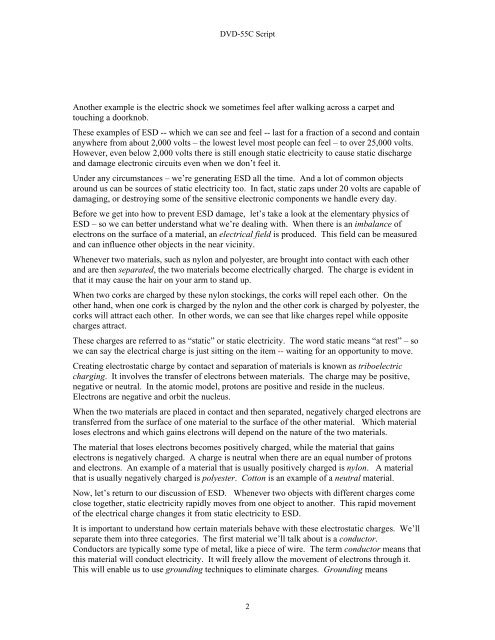DVD-55C ESD Control for IT and Electronics Service Technicians
DVD-55C ESD Control for IT and Electronics Service Technicians
DVD-55C ESD Control for IT and Electronics Service Technicians
- No tags were found...
You also want an ePaper? Increase the reach of your titles
YUMPU automatically turns print PDFs into web optimized ePapers that Google loves.
<strong>DVD</strong>-<strong>55C</strong> ScriptAnother example is the electric shock we sometimes feel after walking across a carpet <strong>and</strong>touching a doorknob.These examples of <strong>ESD</strong> -- which we can see <strong>and</strong> feel -- last <strong>for</strong> a fraction of a second <strong>and</strong> containanywhere from about 2,000 volts – the lowest level most people can feel – to over 25,000 volts.However, even below 2,000 volts there is still enough static electricity to cause static discharge<strong>and</strong> damage electronic circuits even when we don’t feel it.Under any circumstances – we’re generating <strong>ESD</strong> all the time. And a lot of common objectsaround us can be sources of static electricity too. In fact, static zaps under 20 volts are capable ofdamaging, or destroying some of the sensitive electronic components we h<strong>and</strong>le every day.Be<strong>for</strong>e we get into how to prevent <strong>ESD</strong> damage, let’s take a look at the elementary physics of<strong>ESD</strong> – so we can better underst<strong>and</strong> what we’re dealing with. When there is an imbalance ofelectrons on the surface of a material, an electrical field is produced. This field can be measured<strong>and</strong> can influence other objects in the near vicinity.Whenever two materials, such as nylon <strong>and</strong> polyester, are brought into contact with each other<strong>and</strong> are then separated, the two materials become electrically charged. The charge is evident inthat it may cause the hair on your arm to st<strong>and</strong> up.When two corks are charged by these nylon stockings, the corks will repel each other. On theother h<strong>and</strong>, when one cork is charged by the nylon <strong>and</strong> the other cork is charged by polyester, thecorks will attract each other. In other words, we can see that like charges repel while oppositecharges attract.These charges are referred to as “static” or static electricity. The word static means “at rest” – sowe can say the electrical charge is just sitting on the item -- waiting <strong>for</strong> an opportunity to move.Creating electrostatic charge by contact <strong>and</strong> separation of materials is known as triboelectriccharging. It involves the transfer of electrons between materials. The charge may be positive,negative or neutral. In the atomic model, protons are positive <strong>and</strong> reside in the nucleus.Electrons are negative <strong>and</strong> orbit the nucleus.When the two materials are placed in contact <strong>and</strong> then separated, negatively charged electrons aretransferred from the surface of one material to the surface of the other material. Which materialloses electrons <strong>and</strong> which gains electrons will depend on the nature of the two materials.The material that loses electrons becomes positively charged, while the material that gainselectrons is negatively charged. A charge is neutral when there are an equal number of protons<strong>and</strong> electrons. An example of a material that is usually positively charged is nylon. A materialthat is usually negatively charged is polyester. Cotton is an example of a neutral material.Now, let’s return to our discussion of <strong>ESD</strong>. Whenever two objects with different charges comeclose together, static electricity rapidly moves from one object to another. This rapid movementof the electrical charge changes it from static electricity to <strong>ESD</strong>.It is important to underst<strong>and</strong> how certain materials behave with these electrostatic charges. We’llseparate them into three categories. The first material we’ll talk about is a conductor.Conductors are typically some type of metal, like a piece of wire. The term conductor means thatthis material will conduct electricity. It will freely allow the movement of electrons through it.This will enable us to use grounding techniques to eliminate charges. Grounding means2

















